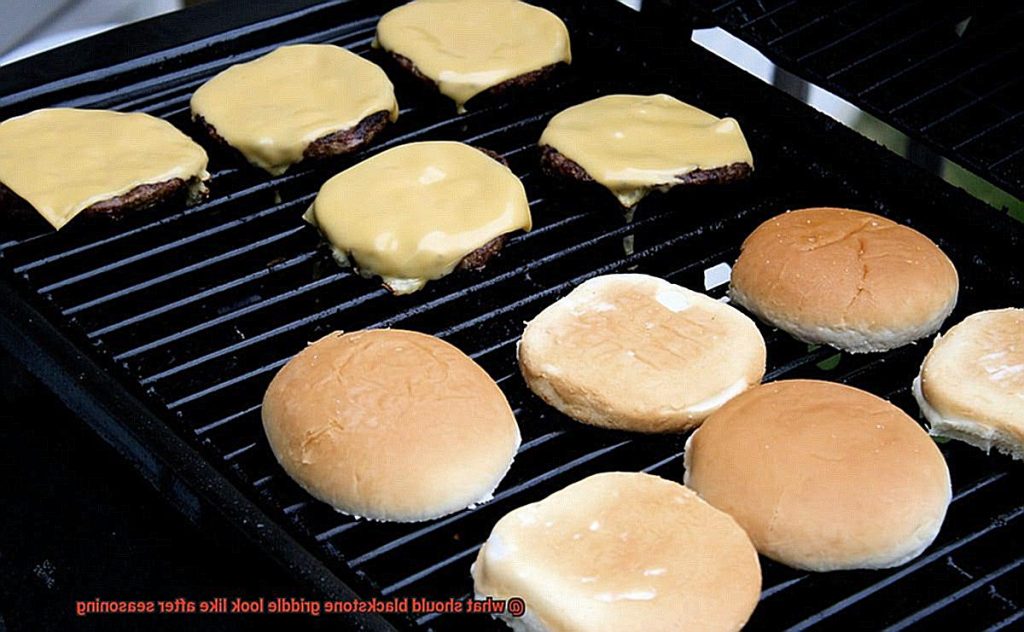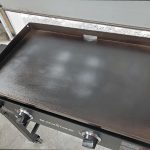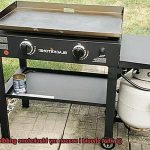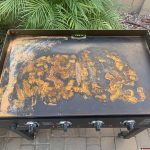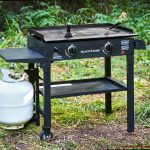So, you’ve got your hands on a shiny new Blackstone griddle and you’re ready to get cooking. But before you start whipping up some delicious meals, it’s important to make sure you’ve properly seasoned your griddle. Not only does seasoning help prevent rust and wear and tear, but it also adds a ton of flavor to your food.
But what should your Blackstone griddle look like after seasoning? Well, for starters, it should have a smooth and glossy coating of oil. You don’t want any uneven or gloppy patches on the surface. And if you do things right, over time you’ll develop a gorgeous deep brown patina that’ll make your griddle look like it belongs in a professional kitchen.
It’s important to note that seasoning is an ongoing process – it’s not just a one-and-done deal. You’ll need to re-oil and re-season your griddle periodically to maintain that protective layer and keep building up that delectable flavor profile. But with a little bit of elbow grease (and our handy guide), you’ll be well on your way to creating restaurant-quality dishes on your Blackstone griddle.
So, whether you’re making breakfast, lunch, or dinner – or even whipping up some late-night snacks – make sure your Blackstone griddle is properly seasoned for the best possible results. Happy cooking.
Contents
What is a Blackstone Griddle?
If you’re passionate about cooking outdoors or looking for an all-purpose grill for your home, the Blackstone Griddle is a perfect choice. This flat-top grill is made of cold-rolled steel and provides a consistent cooking surface that can handle a variety of foods, from burgers to pancakes. It is available in different sizes and shapes, ranging from small portable models to large restaurant-grade units, making it ideal for any setting.
What makes the Blackstone Griddle stand out is its versatility, durability, and ease of use. The griddle is powered by propane or natural gas and has adjustable heat controls that allow you to cook at different temperatures. Some models also come with additional features like built-in side tables, grease management systems, and warming drawers.
However, one of the most crucial aspects of owning a Blackstone Griddle is seasoning it properly. Seasoning involves applying oil to the surface of the griddle to create a non-stick coating that prevents food from sticking and protects the metal from rust and corrosion. A well-seasoned Blackstone Griddle should have a smooth and shiny surface that is free from rust or discoloration.
To season your Blackstone Griddle, start by cleaning it thoroughly with soap and water. Once dry, apply a thin layer of oil using flaxseed oil or vegetable shortening, as they have a high smoke point and can withstand high temperatures. Heat the griddle on medium-high heat for about an hour, allowing the oil to penetrate the metal and create a protective layer. Repeat this process several times until you achieve the desired results.
After seasoning your Blackstone Griddle, cooking on it will be easier and more enjoyable. Your food will have a more intense flavor due to the seasoning, and you won’t have to worry about sticking or burning.
It’s important to note that over time, your Blackstone Griddle may develop rust spots or other imperfections. If this happens, don’t fret. Simply re-season the griddle following the same process outlined above.
Why Should You Season Your Blackstone Griddle?
To get the most out of your Blackstone griddle, it’s crucial to season it correctly.
So, why should you season your Blackstone griddle? Well, there are several reasons why this process is essential for the longevity and quality of your griddle.
Firstly, seasoning creates a non-stick surface that prevents food from sticking and burning. A well-seasoned griddle allows food to slide off effortlessly, ensuring even cooking and making cleanup much easier. Imagine being able to flip your pancakes with ease or sear your steak without worrying about it sticking to the surface.
Secondly, seasoning prevents rust and corrosion on the metal surface of the griddle. Without proper seasoning, rust can accumulate on the surface, affecting its functionality and ruining the appearance of your griddle. This not only affects your cooking experience but also the taste of your food.
Thirdly, seasoning helps distribute heat evenly across the surface of the griddle. This ensures that all parts of the griddle are heated uniformly, preventing hot spots or cold spots that can affect the cooking process. With even heating, you can rest assured that your food will be cooked to perfection every time.
To season your Blackstone griddle correctly, all you need is flaxseed oil or vegetable shortening. Coat the surface of the griddle with a thin layer of oil and heat it up to high temperatures for about an hour. Let it cool down, then repeat the process several times until you notice a shiny black coating on the surface.
How to Prepare the Griddle for Seasoning
Seasoning your Blackstone griddle is an essential step to ensuring that it lasts for years and cooks your food to perfection. However, before you can apply any oil or seasoning, you must first prepare the surface correctly. Here are five sub-sections that will guide you through the process of preparing your griddle for perfect seasoning.
Removing the Protective Coating
The first step in preparing your griddle for seasoning is to remove any protective coating that may have been applied during manufacturing. To do this, follow the manufacturer’s instructions, which usually involve heating the griddle to a high temperature and wiping it down with a clean cloth. This step ensures that the surface is clean and ready for seasoning.
Cleaning the Surface Thoroughly
After removing the protective coating, it’s time to clean the surface thoroughly. Use warm water and soap or a commercial cleaner specifically designed for griddles to remove any dirt, grease, or debris. Scrub the surface with a non-abrasive scrubber and rinse thoroughly with water. Then, dry the surface completely with a towel or cloth to ensure there is no moisture left.
Applying a Thin Layer of Oil
The next step involves applying a thin layer of oil to the griddle’s surface. You can use any high-temperature oil such as vegetable oil, canola oil, or flaxseed oil for this purpose. Use a cloth or paper towel to spread the oil evenly across the griddle’s surface, including the edges and corners. Be sure to cover every inch of the surface.
Heating Up the Griddle
Once you have applied the oil, turn on the heat to medium-high and let the griddle heat up for about 10-15 minutes. This will help to bond the oil to the surface and create a protective layer. During this process, you may notice some smoke coming from the griddle – this is normal and expected.
Letting It Cool Down
After heating up the griddle, turn off the heat and let it cool down naturally. This will allow the oil to bake onto the surface and create a non-stick cooking surface. Once it has cooled down completely, apply another thin layer of oil to the surface and repeat the same process for an additional 30 minutes.
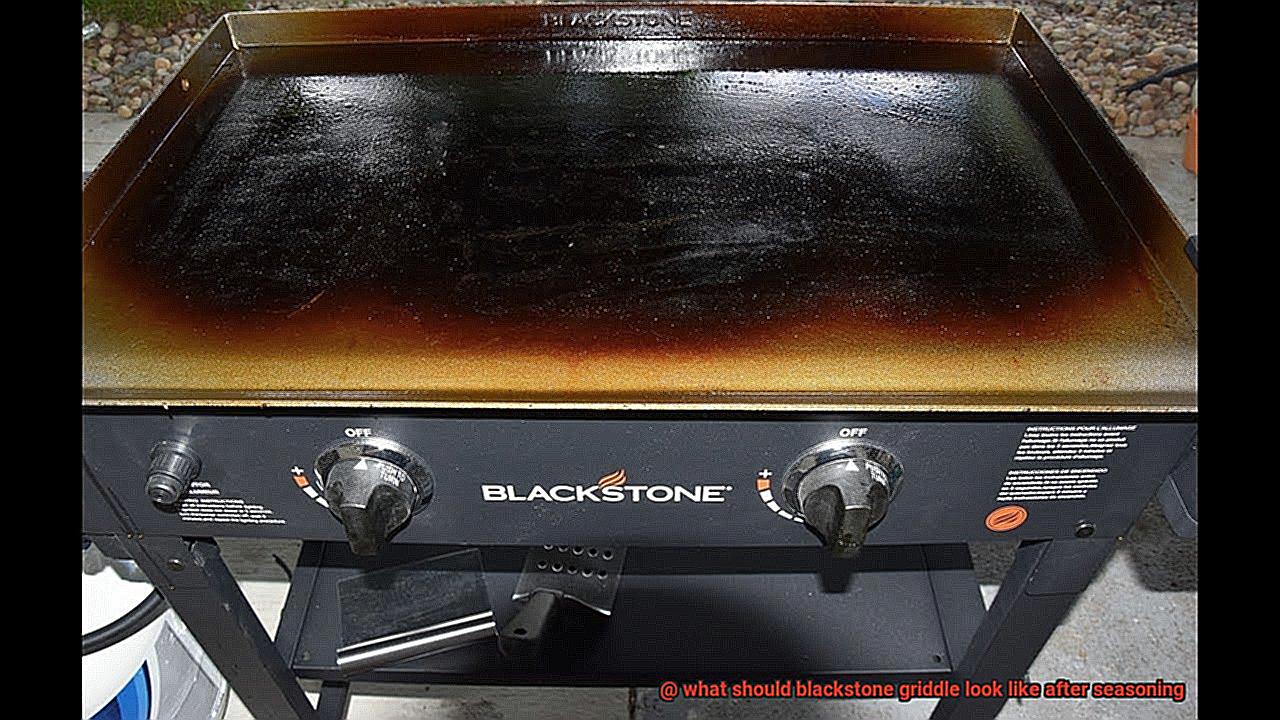
What Kind of Oil Should You Use for Seasoning?
Cooking on a Blackstone griddle is an enjoyable experience for many, but the key to ensuring that it stays in top condition is by seasoning it properly. One of the most crucial factors to consider when seasoning your Blackstone griddle is the type of oil you use. The right oil can create a non-stick surface that makes cooking a breeze, while the wrong oil can leave your griddle sticky and challenging to work with.
There are several types of oils to choose from when it comes to seasoning your Blackstone griddle. Vegetable oil is a popular choice because of its high smoke point and easy availability. It can be used alone or in combination with other oils like canola or grapeseed oil. Canola oil is another excellent option because of its neutral flavor and high smoke point.
For something different, you may want to try flaxseed oil. This oil is high in omega-3 fatty acids, which can help create a durable non-stick surface on your griddle. However, it has a lower smoke point than other oils, so it should be used with caution.
Grapeseed oil is another popular choice for seasoning a Blackstone griddle. With its high smoke point and neutral flavor, it’s perfect for cooking all sorts of dishes. Plus, it’s readily available at most grocery stores.
When selecting the best oil for your Blackstone griddle, there are several factors to consider such as personal preferences and cooking needs. Experiment with different oils until you find the one that works best for you and your griddle. Always remember to apply a thin layer of oil and heat the griddle until the oil starts to smoke before wiping it off with paper towels.
How to Apply the Oil to the Griddle Surface
One of the crucial steps in seasoning a Blackstone griddle is applying oil to the surface. In this blog post, we will guide you through 5 sub-sections on how to apply oil to your Blackstone griddle.
Choosing the Right Oil
To achieve the best results, it is vital to choose the right type of oil. We recommend using high smoke point oils such as flaxseed, canola, or vegetable oil. These oils create a durable coating on the surface of your griddle and prevent rusting. Avoid using low smoke point oils like olive oil or butter, as they tend to burn and create a sticky surface.
Heating up Your Griddle
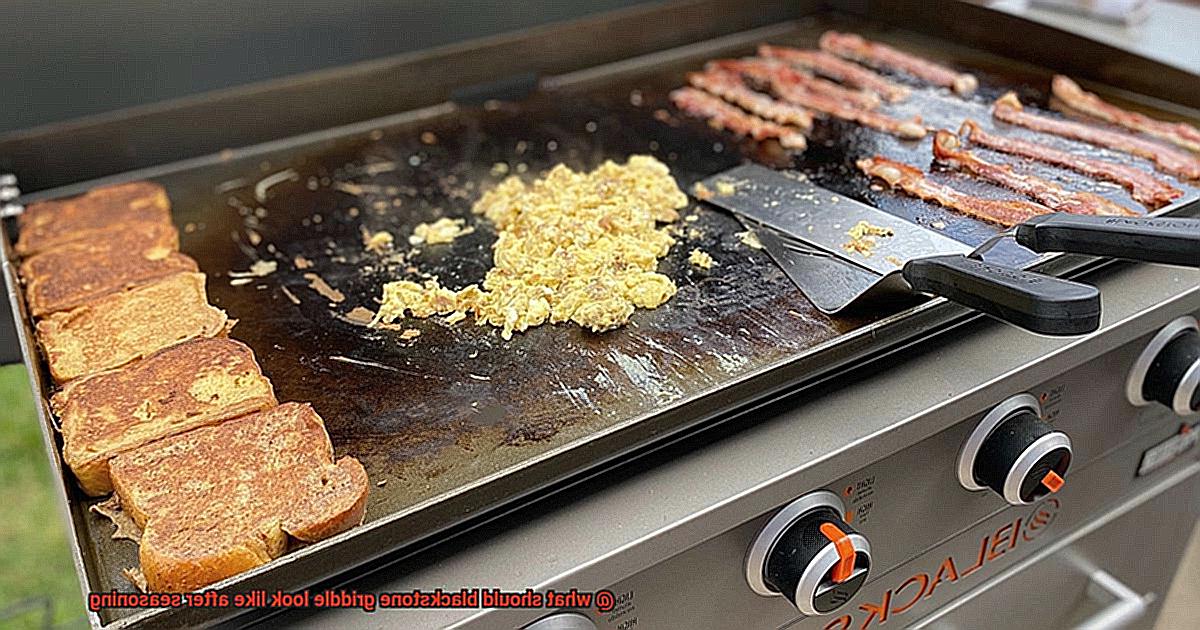
Before applying oil to your griddle, heat it up on high heat until it’s hot. This process helps open up the pores in the metal and allows the oil to seep in better. Once you’ve heated the griddle, turn off the heat and let it cool down slightly.
Applying the Oil
Once your griddle has cooled down slightly, use a paper towel or brush to apply a thin layer of oil to the entire surface of the griddle. It’s crucial to apply the oil evenly and cover all areas of the griddle, including the edges and corners.
Letting it Cook
After applying the oil, let it cook for 15-20 minutes. This step helps bond the oil to the surface and creates a protective coating on your Blackstone griddle. After 20 minutes, turn off the heat and let your griddle cool down completely.
Wiping Off Excess Oil
Once your griddle has cooled down, wipe off any excess oil with a clean paper towel. You should notice that your Blackstone griddle has a smooth and shiny surface after seasoning.
Repeat this process several times to achieve a non-stick surface on your Blackstone griddle. With proper seasoning, your griddle will provide you with years of delicious outdoor cooking fun.
Heating the Griddle for Seasoning
If you’re a true grilling aficionado, then you know that having a well-seasoned griddle is critical to your outdoor cooking success. Not only does it prevent rust from accumulating, but it also creates a non-stick surface that makes cooking a breeze. But before diving into the seasoning process, it’s crucial to know how to properly heat up your Blackstone griddle.
First and foremost, make sure your griddle is sparkling clean and completely dry before heating it up. Then, turn on all the burners to high heat and let it heat up for 10-15 minutes. This process will burn off any residual oil or debris and ensure that the griddle is at the correct temperature for seasoning. Don’t panic if the griddle begins to smoke during this process – it’s completely normal.
After the griddle has been heated, turn off all the burners and allow it to cool down slightly. However, be careful not to let the griddle get too cold before adding oil – this can cause the oil to cling and create a sticky residue on the surface of the griddle.
Now it’s time to add oil for seasoning. Use a high smoke point oil like vegetable or canola oil and apply a thin layer of oil to the surface of the griddle using a paper towel or cloth. Make sure to cover the entire surface of the griddle, including its edges.
With the oil applied, turn on all the burners to high heat again and let it heat up for another 10-15 minutes. This process allows the oil to bond with the surface of the griddle and create an unbeatable non-stick coating.
Once you’ve heated up the griddle for a second time, turn off all the burners and allow it to cool down completely. You should now see a dark, glossy surface with no visible residue or stickiness. If you notice any areas that look sticky or have residue, simply repeat the seasoning process until they disappear.
The Results of a Properly Seasoned Griddle
It’s time to get your Blackstone griddle properly seasoned. Seasoning your griddle is a crucial process that creates a non-stick layer on the surface. This creates a barrier between the griddle and food, preventing sticking and ensuring even cooking. As an expert on this topic, let me break down the results of a properly seasoned Blackstone griddle.
First and foremost, you should notice a striking transformation once your griddle is seasoned. The surface should appear glossy and dark, indicating that the oil has penetrated the metal and created a protective layer. The surface should also be smooth and free of any rough spots, indicating that the oil has filled in any pores or imperfections in the metal.
When you touch the griddle surface, it should feel slightly oily or greasy, but not sticky or gummy. This is because the oil has polymerized, creating a hard, durable layer that can withstand high heat and repeated use. If the surface feels sticky or gummy, it may indicate that too much oil was used during seasoning or that the griddle was not heated enough during the process.
The real test of a well-seasoned Blackstone griddle is how it performs when cooking. You should find that food cooks evenly and releases easily from the surface without sticking. There should be no need to use excessive force or tools to flip or move food around on the griddle. A well-seasoned griddle will also develop a natural patina over time, which is a layer of built-up seasoning that enhances flavor and prevents rusting.
In summary, the results of a properly seasoned Blackstone griddle are a glossy, dark surface that feels slightly oily to the touch. Food should cook evenly and release easily from the surface without sticking. With proper care and maintenance, your well-seasoned griddle can provide years of delicious outdoor cooking enjoyment. Here’s a recap of the results:
- Glossy, dark surface
- Smooth and free of rough spots
- Slightly oily or greasy to the touch
- Even cooking and easy food release
- Natural patina development over time
Maintaining Your Griddle After Seasoning
Don’t stop there – maintaining your griddle is just as important as seasoning it. As a seasoned expert on “Maintaining Your Griddle After Seasoning,” I have compiled some research notes that will help you keep your griddle in pristine condition for years to come.
Firstly, regular cleaning is essential to maintain the shiny, dark surface of your griddle. Using a scraper or spatula, remove any food debris and grease from the surface. Avoid using abrasive materials like steel wool or harsh chemicals like bleach, as they can damage the seasoning and cause rust. Instead, use a mixture of warm water and mild dish soap to clean your griddle’s surface. You can also use a commercial griddle cleaner specifically designed for Blackstone griddles. Rinse thoroughly with water and dry the surface completely with a towel or cloth.
To ensure your griddle stays non-stick and rust-free, oil it regularly after cleaning. A thin layer of high-heat oil like vegetable oil, canola oil, or flaxseed oil should be applied using a paper towel or cloth. This helps maintain the surface’s non-stick quality and prevents rust from forming.
In addition to regular cleaning and oiling, proper storage is crucial to maintain your griddle’s longevity. Always store your griddle in a dry place away from moisture and humidity. If you live in a region with high humidity, consider storing your griddle indoors or covering it with a waterproof cover when not in use.
VspmDVnj2pI” >
Conclusion
After seasoning your Blackstone griddle, it should look dark and shiny, with a smooth and even surface.
The seasoning process creates a protective layer of oil that prevents rust and makes cooking easier. A well-seasoned griddle will also have a non-stick surface that allows you to cook without food sticking or burning.
To achieve the perfect seasoning, make sure to clean your griddle thoroughly before applying a thin layer of oil and heating it up until it starts smoking. Repeat this process several times until you get the desired results.
Remember to take care of your Blackstone griddle by cleaning it after each use and reseasoning it regularly to maintain its quality and longevity.

